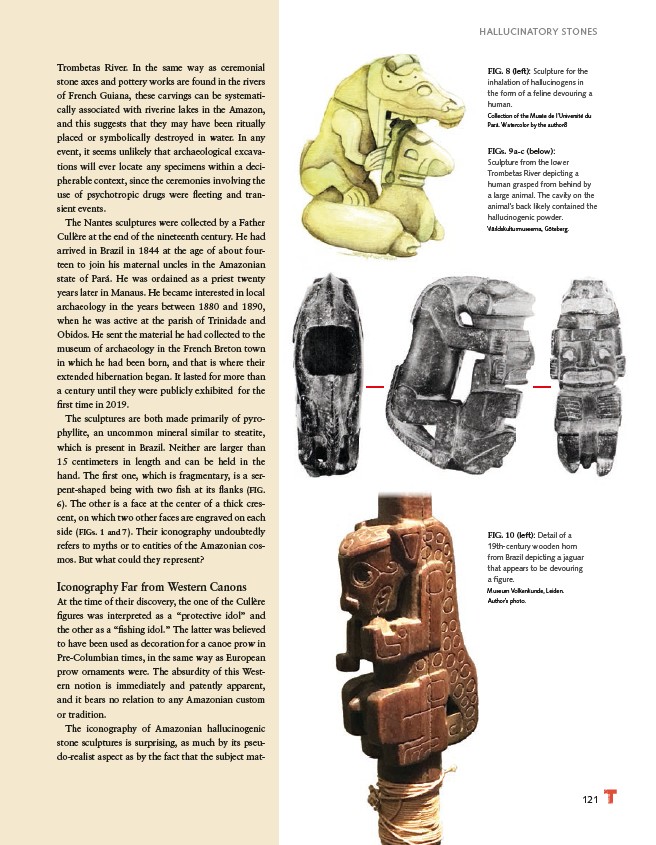
FIG. 8 (left): Sculpture for the
inhalation of hallucinogens in
the form of a feline devouring a
human.
Collection of the Musée de l’Université du
Pará. Watercolor by the author8
FIGs. 9a-c (below):
Sculpture from the lower
Trombetas River depicting a
human grasped from behind by
a large animal. The cavity on the
animal’s back likely contained the
hallucinogenic powder.
Världskulturmuseerna, Göteberg.
FIG. 10 (left): Detail of a
19th-century wooden horn
from Brazil depicting a jaguar
that appears to be devouring
a fi gure.
Museum Volkenkunde, Leiden.
Author’s photo.
121
Trombetas River. In the same way as ceremonial
stone axes and pottery works are found in the rivers
of French Guiana, these carvings can be systematically
associated with riverine lakes in the Amazon,
and this suggests that they may have been ritually
placed or symbolically destroyed in water. In any
event, it seems unlikely that archaeological excavations
will ever locate any specimens within a decipherable
context, since the ceremonies involving the
use of psychotropic drugs were fl eeting and transient
events.
The Nantes sculptures were collected by a Father
Cullère at the end of the nineteenth century. He had
arrived in Brazil in 1844 at the age of about fourteen
to join his maternal uncles in the Amazonian
state of Pará. He was ordained as a priest twenty
years later in Manaus. He became interested in local
archaeology in the years between 1880 and 1890,
when he was active at the parish of Trinidade and
Obidos. He sent the material he had collected to the
museum of archaeology in the French Breton town
in which he had been born, and that is where their
extended hibernation began. It lasted for more than
a century until they were publicly exhibited for the
fi rst time in 2019.
The sculptures are both made primarily of pyrophyllite,
an uncommon mineral similar to steatite,
which is present in Brazil. Neither are larger than
15 centimeters in length and can be held in the
hand. The fi rst one, which is fragmentary, is a serpent
shaped being with two fi sh at its fl anks (FIG.
6). The other is a face at the center of a thick crescent,
on which two other faces are engraved on each
side (FIGs. 1 and 7). Their iconography undoubtedly
refers to myths or to entities of the Amazonian cosmos.
But what could they represent?
Iconography Far from Western Canons
At the time of their discovery, the one of the Cullère
fi gures was interpreted as a “protective idol” and
the other as a “fi shing idol.” The latter was believed
to have been used as decoration for a canoe prow in
Pre-Columbian times, in the same way as European
prow ornaments were. The absurdity of this Western
notion is immediately and patently apparent,
and it bears no relation to any Amazonian custom
or tradition.
The iconography of Amazonian hallucinogenic
stone sculptures is surprising, as much by its pseudo
realist aspect as by the fact that the subject mat-
HALLUCINATORY STONES